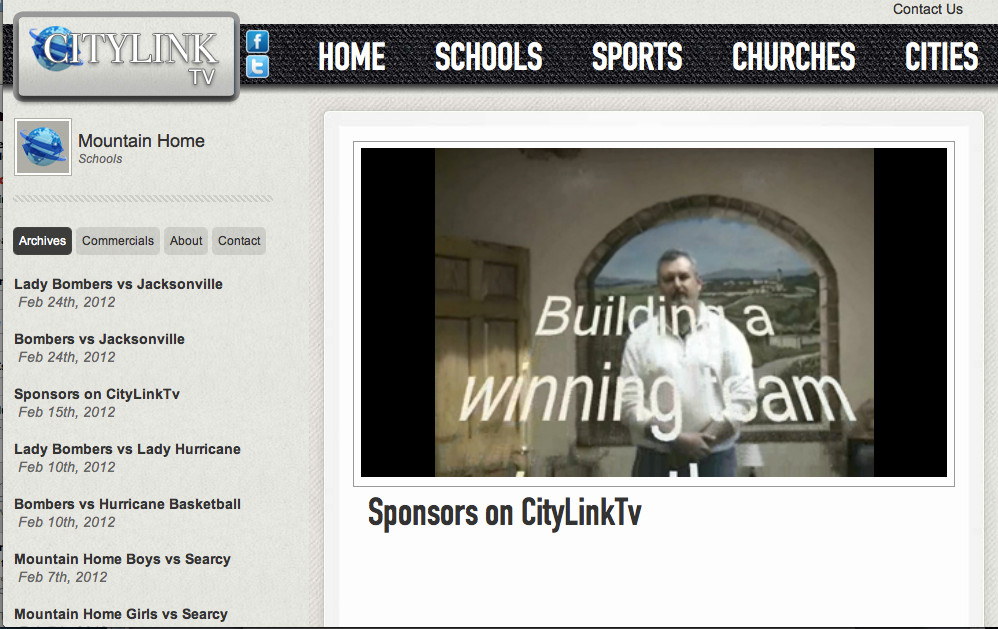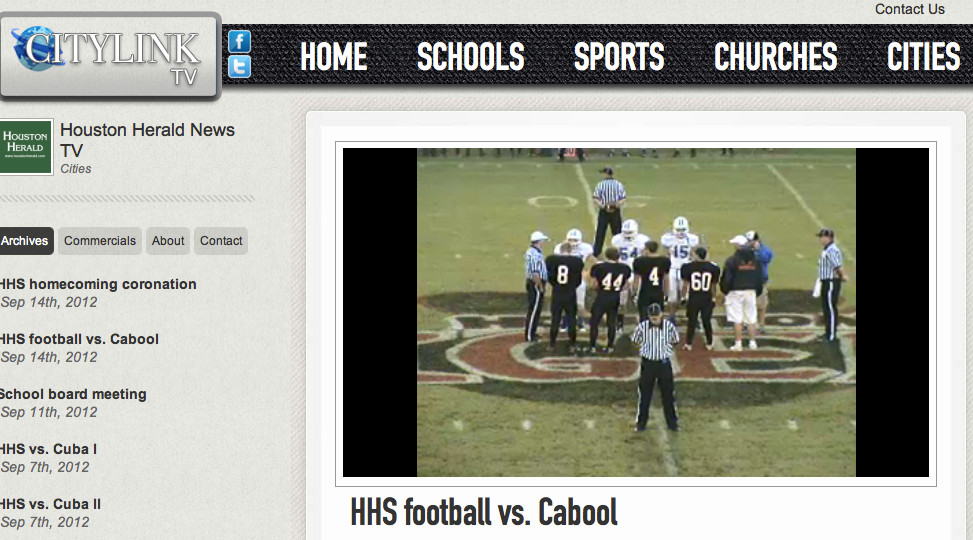Live streaming high school sports on a budget at the Houston Herald
A key local franchise is easy to grab with just a few new tricks
Market: Houston, Missouri, population 2010
Company: Houston Herald
Traffic: 700,000 pageviews monthly
Initiative: Live streaming high school sports
Key executive: Jeff McNiell, Assistant editor
Challenge: When Jeff McNiell moved from a big city daily to become assistant editor of the Houston Herald, in Houston Missouri six years ago colleagues told him it would be “career suicide.” Instead he’s wound up in charge one of the most innovative news teams in the area. And “by far” the most popular initiative with readers in town is video coverage of high school sports. The initiative immediate sold out to eight local advertisers and became the talk of the town.
With a population of just 2000, the newspaper company had to stream high school sports without extra staff or significant expense. Their strategy is so efficient in it simplicity, that the company plans to expand video streaming coverage into other areas.
Getting started
A minimum amount of technology is needed to stream local sports. The HoustonHerald.com started with a platform created by CityLinkTV, which charges $350 a year for an exclusive per DMA partnership. They are based mostly in the mid-west and have about 50 smallish communities aggregated.
Other technology required includes two headset mikes and a four channel mixer, a video camera with three (red, white and yellow) wires that plug in, a PC laptop that will go on site during games, and a Verizon wireless card to ensure internet access. Here's how to make it all work together:
1. When users sign up on CitylinkTV, the site prompts them to download Flash Media Live Encoder 3.2, a free platform provided by Adobe that supports video and audio streaming.
2. McNeill purchased a Sony video camera; the only stipulation for the camera type is that it has to have the three (red, white yellow) wires. This camera is actually cheaper than the latest models, since this technology is older.
3. At each game, MacNeill sets up the video camera on a tri-pod in a box above the field, so the camera is looking down at the field. In this case, he uses a short tripod set on a table. Shooting through a window or screen doesn’t work, so he opened the window and removed the screen. The three colored wires from the video cam plug into an Ion Video 2 PC digital video converter, which costs less than $40, and convert the stream into digital video. The converter plugs into the PC.
4. To record the announcers, MacNeill purchased two inexpensive Yamaha microphone headsets which plug into a four channel mixer, then into the lap top (theoretically you could plug in four announcers with headsets, but Houston uses just two).
5. Once the cameras are set up and on, the announcer simply opens Adobe encoder and presses “Start.” The encoder starts recording the game and commentary.
6. Finally, the producer opens CityLinkTV.com on the laptop and clicks “go live." The live streaming begins.
7. To end the program, the producer clicks “shut down" on CityLinkTV.com, and stops the encoder, which saves a flash file on the desktop and uploads it to the CityLinkTV web site archive. There is no editing required.
McNeill, who has a sports background, does some of the commentary; but he said there has been no shortage of community volunteers. Schools were so excited to have live coverage the head of the sports department also narrates the games with him. A family friend sometimes runs the camera. "We spent no money on the people providing the broadcast."
The program is promoted in the newspaper and on the website, instructing visitors to go to Houstonherald.com/live when the game begins. This URL is redirected to the CityLinkTV.com site.
Advertising
The platform comes with eight ad units built in. Advertisers are also guaranteed that a promotional line will be read four times, and get a video which is played on the web site.
Results:
• The live video channel received 805 views the opening game and 1,307 the next Friday night (in a town of 2000).
• The eight sponsorships are sold out at $100 each per month. MacNeil says that this was just the pre-launch pricing, and advertisers can be charged more.
• "It's by far the most well received thing we have done. I can’t go anywhere in town or church with people talking about it."
• Players and peope who missed games can access the archives to review them.
• Hosting on CitylinkTV.com saves on bandwidth charges; "otherwise they would be outrageous."
• Radio coverage of high school sports was dropped. "It made the radio obsolete."
• One Friday night when there was a power outage in the stadium, MacNeill encouraged visitors who were watching to go to the Facebook page and "Tell us where you are watching from." The result filled up the Facebook page and gave announcers something to talk about.
•The platform has since been used successfully for school board meetings (no announcer required) and more live streaming coverage is planned.
Our take:
Print companies who develop video competency are able to secure franchises that would otherwise be vulnerable to new players in the market - especially important in small towns and cities.
Larger towns have more opportunities for monetization. Prices could be easily increase from $100 a month to $100 or $120 a week, with added value for tiered packages. Here are some value-adds that generate higher investment:
- Package with print/onaire by promoting a Player of the Week segment in onair/print media (this package produced $42,000 for a local TV station).
- Produce a professional-quality video for merchants that can be used on a directory, web site or YouTube and charge upfront for it. Include an upsell to a directory package as part of the sponsorship.
- Add contesting and data collection opportunities, to create "title" sponsorships. Top candidates include companies who typically like sports (car dealers have sponsored high school sports as well as college sports), family restaurants (Dairy Queen), pediatric dentists and orthodontists, grocery stores (especially in conjunction with healthy recipes contests for mom's) and so on. For more ideas see this list "Who buys which contests."
Many thanks to Jeff Mcneill for sharing this innovative community-oriented editorial initiative. He can be reached at jmcniell@houstonherald.com, 417.967.2000.

The author, Alisa Cromer is publisher of a variety of online media, including LocalMediaInsider and MediaExecsTech, developed while on a fellowship with the Reynolds Journalism Institute and which has evolved into a leading marketing company for media technology start-ups. In 2017 she founded Worldstir.com, an online magazine, to showcases perspectives from around the world on new topic each month, translated from and to the top five languages in the world.









